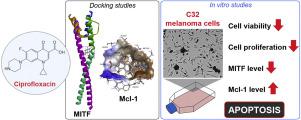当前位置:
X-MOL 学术
›
Toxicol. In Vitro
›
论文详情
Our official English website, www.x-mol.net, welcomes your
feedback! (Note: you will need to create a separate account there.)
The role of MITF and Mcl-1 proteins in the antiproliferative and proapoptotic effect of ciprofloxacin in amelanotic melanoma cells: In silico and in vitro study.
Toxicology in Vitro ( IF 2.6 ) Pub Date : 2020-05-08 , DOI: 10.1016/j.tiv.2020.104884 Artur Beberok 1 , Jakub Rok 1 , Zuzanna Rzepka 1 , Krzysztof Marciniec 2 , Stanisław Boryczka 2 , Dorota Wrześniok 1
Toxicology in Vitro ( IF 2.6 ) Pub Date : 2020-05-08 , DOI: 10.1016/j.tiv.2020.104884 Artur Beberok 1 , Jakub Rok 1 , Zuzanna Rzepka 1 , Krzysztof Marciniec 2 , Stanisław Boryczka 2 , Dorota Wrześniok 1
Affiliation

|
Mcl-1 is a potent antiapoptotic protein which is amplified in many human cancer, while microphthalmia associated transcription factor (MITF) promotes cell proliferation and has pro-survival role. The study was designed to examine whether the interaction between ciprofloxacin, one of the fluoroquinolones derivative, and MITF/Mcl-1 proteins affects C32 melanoma cells viability, proliferation and induces apoptosis. Preliminary molecular docking studies, Western blot analysis and fluorescence image cytometry were applied to demonstrate the signaling pathway underlying antiproliferative and proapoptotic effect of the drug. In silico analysis showed that ciprofloxacin possess the ability to form complexes with MITF and Mcl-1proteins. This phenomenon was confirmed by in vitro experimental model where the drug was found to decrease MITF and increase Mcl-1 expression at the protein level. Moreover, we found that ciprofloxacin decreases the cell viability and exerts anti-proliferative effect on amelanotic C32 melanoma cells. Image cytometric studies showed that the tested drug induced GSH depletion and apoptosis via intrinsic death pathway leading to DNA fragmentation. Analysis of the cell cycle distribution revealed that ciprofloxacin caused a block in the G2/M phase. This is the first study that characterized the role of MITF and Mcl-1 proteins in the antiproliferative and pro-apoptotic effect of ciprofloxacin towards amelanotic melanoma cells, opening the possibility to use of this drug as a potential agent for the treatment of melanoma.
中文翻译:

MITF和Mcl-1蛋白在环丙沙星对黑素瘤黑素瘤细胞的抗增殖和促凋亡作用中的作用:计算机和体外研究。
Mcl-1是一种有效的抗凋亡蛋白,可在许多人类癌症中扩增,而小眼症相关转录因子(MITF)则可促进细胞增殖并具有促生存作用。该研究旨在检查氟喹诺酮衍生物之一环丙沙星与MITF / Mcl-1蛋白之间的相互作用是否影响C32黑色素瘤细胞的活力,增殖并诱导凋亡。初步的分子对接研究,Western印迹分析和荧光图像细胞术被用于证明该药物的抗增殖和促凋亡作用的信号传导途径。电脑分析表明,环丙沙星具有与MITF和Mcl-1蛋白形成复合物的能力。通过体外实验模型证实了这种现象,其中发现该药物在蛋白质水平上降低了MITF并增加了Mcl-1表达。此外,我们发现环丙沙星降低了细胞活力,并对釉质C32黑色素瘤细胞发挥了抗增殖作用。图像细胞术研究表明,受试药物通过内在的死亡途径诱导GSH耗竭和凋亡,从而导致DNA断裂。细胞周期分布的分析表明,环丙沙星引起了G2 / M期的阻滞。这是第一个表征MITF和Mcl-1蛋白在环丙沙星对黑色素瘤黑素瘤细胞的抗增殖和促凋亡作用中的作用的研究,从而开辟了将该药用作治疗黑素瘤的潜在药物的可能性。此外,我们发现环丙沙星降低了细胞活力,并对釉质C32黑色素瘤细胞发挥了抗增殖作用。图像细胞术研究表明,受试药物通过内在死亡途径诱导GSH耗竭和凋亡,导致DNA断裂。细胞周期分布的分析表明,环丙沙星引起了G2 / M期的阻滞。这是第一个表征MITF和Mcl-1蛋白在环丙沙星对黑色素瘤黑素瘤细胞的抗增殖和促凋亡作用中的作用的首次研究,从而开辟了将该药用作治疗黑素瘤的潜在药物的可能性。此外,我们发现环丙沙星降低了细胞活力,并对釉质C32黑色素瘤细胞发挥了抗增殖作用。图像细胞术研究表明,受试药物通过内在的死亡途径诱导GSH耗竭和凋亡,从而导致DNA断裂。细胞周期分布的分析表明,环丙沙星引起了G2 / M期的阻滞。这是第一个表征MITF和Mcl-1蛋白在环丙沙星对黑色素瘤黑素瘤细胞的抗增殖和促凋亡作用中的作用的首次研究,从而开辟了将该药用作治疗黑素瘤的潜在药物的可能性。图像细胞术研究表明,受试药物通过内在的死亡途径诱导GSH耗竭和凋亡,从而导致DNA断裂。细胞周期分布的分析表明,环丙沙星引起了G2 / M期的阻滞。这是第一个表征MITF和Mcl-1蛋白在环丙沙星对黑色素瘤黑素瘤细胞的抗增殖和促凋亡作用中的作用的研究,从而开辟了将该药用作治疗黑素瘤的潜在药物的可能性。图像细胞术研究表明,受试药物通过内在死亡途径诱导GSH耗竭和凋亡,导致DNA断裂。细胞周期分布的分析表明,环丙沙星引起了G2 / M期的阻滞。这是第一个表征MITF和Mcl-1蛋白在环丙沙星对黑色素瘤黑素瘤细胞的抗增殖和促凋亡作用中的作用的研究,从而开辟了将该药用作治疗黑素瘤的潜在药物的可能性。
更新日期:2020-05-08
中文翻译:

MITF和Mcl-1蛋白在环丙沙星对黑素瘤黑素瘤细胞的抗增殖和促凋亡作用中的作用:计算机和体外研究。
Mcl-1是一种有效的抗凋亡蛋白,可在许多人类癌症中扩增,而小眼症相关转录因子(MITF)则可促进细胞增殖并具有促生存作用。该研究旨在检查氟喹诺酮衍生物之一环丙沙星与MITF / Mcl-1蛋白之间的相互作用是否影响C32黑色素瘤细胞的活力,增殖并诱导凋亡。初步的分子对接研究,Western印迹分析和荧光图像细胞术被用于证明该药物的抗增殖和促凋亡作用的信号传导途径。电脑分析表明,环丙沙星具有与MITF和Mcl-1蛋白形成复合物的能力。通过体外实验模型证实了这种现象,其中发现该药物在蛋白质水平上降低了MITF并增加了Mcl-1表达。此外,我们发现环丙沙星降低了细胞活力,并对釉质C32黑色素瘤细胞发挥了抗增殖作用。图像细胞术研究表明,受试药物通过内在的死亡途径诱导GSH耗竭和凋亡,从而导致DNA断裂。细胞周期分布的分析表明,环丙沙星引起了G2 / M期的阻滞。这是第一个表征MITF和Mcl-1蛋白在环丙沙星对黑色素瘤黑素瘤细胞的抗增殖和促凋亡作用中的作用的研究,从而开辟了将该药用作治疗黑素瘤的潜在药物的可能性。此外,我们发现环丙沙星降低了细胞活力,并对釉质C32黑色素瘤细胞发挥了抗增殖作用。图像细胞术研究表明,受试药物通过内在死亡途径诱导GSH耗竭和凋亡,导致DNA断裂。细胞周期分布的分析表明,环丙沙星引起了G2 / M期的阻滞。这是第一个表征MITF和Mcl-1蛋白在环丙沙星对黑色素瘤黑素瘤细胞的抗增殖和促凋亡作用中的作用的首次研究,从而开辟了将该药用作治疗黑素瘤的潜在药物的可能性。此外,我们发现环丙沙星降低了细胞活力,并对釉质C32黑色素瘤细胞发挥了抗增殖作用。图像细胞术研究表明,受试药物通过内在的死亡途径诱导GSH耗竭和凋亡,从而导致DNA断裂。细胞周期分布的分析表明,环丙沙星引起了G2 / M期的阻滞。这是第一个表征MITF和Mcl-1蛋白在环丙沙星对黑色素瘤黑素瘤细胞的抗增殖和促凋亡作用中的作用的首次研究,从而开辟了将该药用作治疗黑素瘤的潜在药物的可能性。图像细胞术研究表明,受试药物通过内在的死亡途径诱导GSH耗竭和凋亡,从而导致DNA断裂。细胞周期分布的分析表明,环丙沙星引起了G2 / M期的阻滞。这是第一个表征MITF和Mcl-1蛋白在环丙沙星对黑色素瘤黑素瘤细胞的抗增殖和促凋亡作用中的作用的研究,从而开辟了将该药用作治疗黑素瘤的潜在药物的可能性。图像细胞术研究表明,受试药物通过内在死亡途径诱导GSH耗竭和凋亡,导致DNA断裂。细胞周期分布的分析表明,环丙沙星引起了G2 / M期的阻滞。这是第一个表征MITF和Mcl-1蛋白在环丙沙星对黑色素瘤黑素瘤细胞的抗增殖和促凋亡作用中的作用的研究,从而开辟了将该药用作治疗黑素瘤的潜在药物的可能性。











































 京公网安备 11010802027423号
京公网安备 11010802027423号